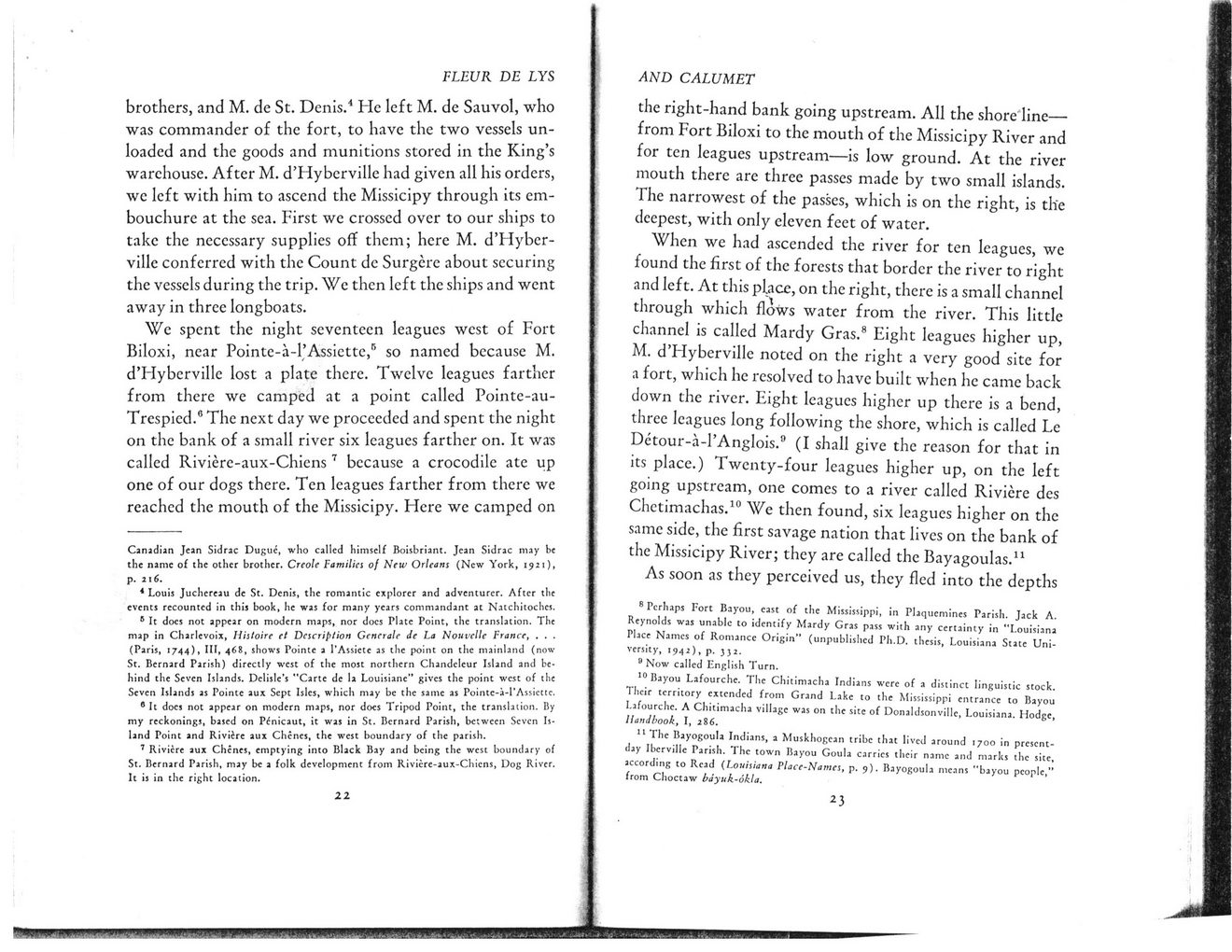This text was obtained via automated optical character recognition.
It has not been edited and may therefore contain several errors.
FLEUR DE LYS brothers, and M. de St. Denis.4 He left M. de Sauvol, who was commander of the fort, to have the two vessels unloaded and the goods and munitions stored in the King’s warehouse. After M. d’Hyberville had given all his orders, we left with him to ascend the Missicipy through its embouchure at the sea. First we crossed over to our ships to take the necessary supplies off them; here M. d’Hybcr-ville conferred with the Count de Surgere about securing the vessels during the trip. We then left the ships and went away in three longboats. We spent the night seventeen leagues west of Fort Biloxi, near Pointe-a-l’Assiette,5 so named because M. d’Hyberville lost a plate there. Twelve leagues farther from there we camped at a point called Pointe-au-Trespied.0 The next day we proceeded and spent the night on the bank of a small river six leagues farther on. It was called Rivierc-aux-Chiens7 because a crocodile ate up one of our dogs there. Ten leagues farther from there we reached the mouth of the Missicipy. Here we camped on Canadian Jean Sidrac Dugue, who called himself Boisbriant. Jean Sidrac may be the name of the other brother. Creole Families of New Orleans (New York, 1921), p. 216. * Louis Juchcreau de St. Denis, the romantic explorer and adventurer. After the events recounted in this book, he was for many years commandant at Natchitoches. 6 It docs not appear on modern maps, nor docs Plate Point, the translation. The map in Charlevoix, Iiistoire et Description Gencrale de La Nouvelle France, * . . (Paris, 1744), 468, shows Pointe a l’Assiete as the point on the mainland (now St. Bernard Parish) directly west of the most northern Chandcleur Island and behind the Seven Islands. Dclisle’s "Carte de la Louisiane” gives the point west of the Seven Islands as Pointe aux Sept Isles, which may be the same as Pointe-a-l’Assicttc. 6 It docs not appear on modern maps, nor docs Tripod Point, the translation. By my reckonings, based on P^nicaut, it was in St. Bernard Parish, between Seven Island Point and Riviire aux Chencs, the west boundary of the parish. 7 Rividre aux Chcnes, emptying into Black Bay and being the west boundary of St. Bernard Parish, may be a folk development from Riviere-aux-Chiens, Dog River. It is in the right location. 11 AND CALUMET the right-hand bank going upstream. All the shoreline— from Fort Biloxi to the mouth of the Missicipy River and for ten leagues upstream—is low ground. At the river mouth there are three passes made by two small islands. The narrowest of the passes, which is on the right, is the deepest, with only eleven feet of water. When we had ascended the river for ten leagues, we found the first of the forests that border the river to right and left. At this place, on the right, there is a small channel through which flows water from the river. This little channel is called Mardy Gras.8 Eight leagues higher up, M. d’PIyberville noted on the right a very good site for a fort, which he resolved to have built when he came back down the river. Eight leagues higher up there is a bend, three leagues long following the shore, which is called Le Detour-a-rAnglois.fl (I shall give the reason for that in its place.) Twenty-four leagues higher up, on the left going upstream, one comes to a river called Riviere des Chetimachas.10 We then found, six leagues higher on the same side, the first savage nation that lives on the bank of the Missicipy River; they are called the Bayagoulas.11 As soon as they perceived us, they fled into the depths 8 Perhaps Fort Bayou, east of the Mississippi, in Plaquemines Parish. Jack A. Reynolds was unable to identify Mardy Gras pass with any certainty in "Louisiana Place Names of Romancc Origin” (unpublished Ph.D. thesis, Louisiana State University, 1942), p. 332. 9 Now called English Turn. 10 Bayou Lafourche. The Chitimacha Indians were of a distinct linguistic stock. Their territory extended from Grand Lake to the Mississippi entrance to Bayou Lafourche. A Chitimacha village was on the site of Donaldsonvillc, Louisiana. Hodge, Handbook, I, 286. 11 The Bayogoula Indians, a Muskhogcan tribe that lived around 1700 in present-day Iberville Parish. The town Bayou Goula carries their name and marks the site, according to Read (Louisiana Place-Names, p, 9). Bayogoula means "bayou people,” from Choctaw bayuk-okla. 23

Penicaut Narrative Document (009)